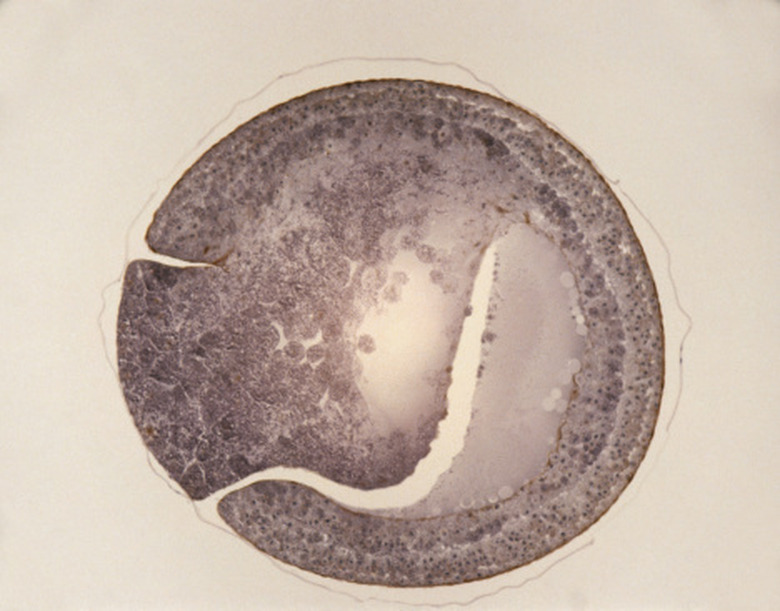Difference Between Differentiation & Morphogenesis
In developmental biology, scientists use different terms to describe different developmental processes. Cell differentiation and the process of morphogenesis are terms referring to two different processes in development.
To define morphogenesis and cell differentiation, it helps to study examples of each.
TL;DR (Too Long; Didn't Read)
Differentiation and morphogenesis represent two different terms that address the development of biological organisms. Differentiation refers to how cells become specialized, whereas morphogenesis refers to the development of the forms of living organisms.
Morphogenesis Definition
Morphogenesis Definition
The process of morphogenesis refers to the development of the forms in living organisms. This refers to the shape, size and connectivity of developing forms.
Scientists use mathematics to help determine growth rate changes that affect an organism's developing shapes. These changes in forms can span both individual development as well as evolutionary development across species. Given the vast possibility of how many shapes could be formed in an organism, it makes sense that constraints such as time, pressure and space play a role in morphogenesis.
Cell morphogenesis refers to the size, shape, position and number of cells.
Examples of Morphogenesis
Examples of Morphogenesis
When seeking to define morphogenesis, it helps to use a morphogenesis example. One such morphogenesis example would be plant growth and how new plants change shape to be either straight or twisting or branching.
In people, intestines provide a morphogenesis example. The manner in which human intestines twist and fold in order to fit inside the body is one way of thinking about morphogenesis in development.
The human brain gives a remarkable morphogenesis example due to its "wrinkles" or folds. In a human fetus, the brain is comparatively smooth. But through the course of healthy development, folding results due to the geometrical space in which the brain grows. Another morphogenesis example is that of the branching in the human kidney.
Recent research seeks to understand how the genes affect geometry and shapes changing in biological organisms.
What Is Differentiation?
What Is Differentiation?
In addition to the process of morphogenesis, differentiation is a term commonly used in cell and developmental biology. Cellular differentiation refers to the process by which cells become specialized into different types with different functions. In contrast to the process of morphogenesis, differentiation occurs at the cellular level and is controlled by transcription factors.
Tissues need a bank of stem cells to provide a backup in the event of cell loss. Transcription factors are proteins that have instructions or directions for how stem cells should go on to be developed. Stem cells will produce a set of daughters cells (or progenitor cells) that can differentiate to form a particular tissue, and another set of daughter cells that maintains the stem cell pool.
An Example of Differentiation
An Example of Differentiation
In the human body, cells are constantly called upon to differentiate into **specialized cells** with unique functions. One such example is the lung basal cell. This cell can differentiate so that it becomes a secretory cell lining the lung tissue.
Transcription factors work to make this differentiation possible. In the case of the lung basal cell, the transcription factor "grainyhead-like 2" sorts the process that the cell will take to become ciliated.
Cells can differentiate into numerous other types of cells, such as cardiomyocytes (heart cells), neurons, skeletal myocytes and so on.
Implications for Medicine
Implications for Medicine
Cell differentiation and the process of morphogenesis both play huge roles in the development of organisms. Scientists hope to gain greater understanding into both of these disciplines to help provide novel medical treatments.
One new avenue of research entails uncovering how genes code for geometry, opening up greater understanding of the origin of morphogenesis. This will involve a multidisciplinary approach by biologists, physicists and mathematicians.
Regarding cell differentiation into specialized cells, scientists hope to uncover how to direct cellular differentiation in order to combat diseases related to specific cell types. One such example is Huntington's disease.
Another major example is that of stem cell therapy for cancer and other diseases. Researchers hope to direct cellular differentiation without the need of bone marrow donors. Macular degeneration of the eye represents another instance in which retinal-pigmented epithelial cells could be proliferated in vitro to replace those lost in aging patients.
It is possible to direct cell differentiation in the lab. Hopefully, by learning how to control this process, researchers will be able to save and improve lives.
References
- Phys.org: Morphogenesis and the Development of Living Forms
- Development: Morphogenesis One Century After On Growth and Form
- Scitable by Nature Education: Cell Differentiation and Tissue
- Development: From Stem Cells to Human Development: a Distinctly Human Perspective on Early Embryology, Cellular Differentiation and Translational Research
Cite This Article
MLA
Hermance, Dianne. "Difference Between Differentiation & Morphogenesis" sciencing.com, https://www.sciencing.com/difference-between-differentiation-morphogenesis-8531897/. 29 April 2019.
APA
Hermance, Dianne. (2019, April 29). Difference Between Differentiation & Morphogenesis. sciencing.com. Retrieved from https://www.sciencing.com/difference-between-differentiation-morphogenesis-8531897/
Chicago
Hermance, Dianne. Difference Between Differentiation & Morphogenesis last modified March 24, 2022. https://www.sciencing.com/difference-between-differentiation-morphogenesis-8531897/
